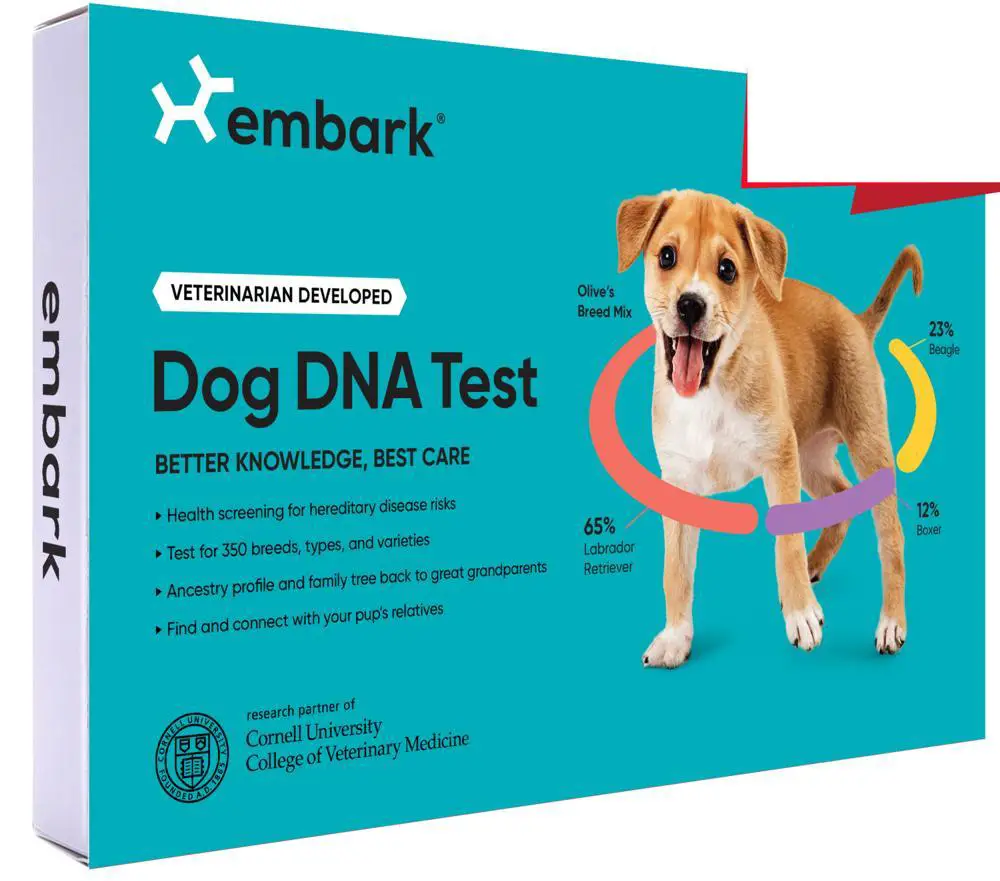Last updated on April 21st, 2022 at 08:35 pm
Dr. Jaime Whittenburg, DVM, contributed to this article. Dr. Whittenburg is a veterinarian and freelance writer with 15 years of clinical experience in small animal general practice, surgery, equine practice, and academia.
My poodle is a standard poodle. She is red in color. She has a majestic and elegant poodle swagger. She makes heads turn everywhere she goes. Because of the attention, she draws, and because of her red/golden color, people always ask me: “Is that a Goldendoodle?”. Sometimes people just comment, “What a lovely Goldendoodle”. I get questions and comments like these more when her hair is long and unclipped.
I have to say, I have nothing against doodles or mixed dogs. Just like everything else, doodles have their pros and their cons. However, I am a poodle fanatic, and I will always be.
I am sure my poodle is purebred because she comes from a breeder that has been breeding poodles for more than 30 years. Furthermore, the breeder provided me the AKC registration papers for my poodle. The AKC keeps records of the lineage of dogs and only dogs that come from verifiable purebred lineage are issued AKC registration papers.
Sometimes, people find it hard to tell if a dog is a poodle or not. Even, some new poodle owners or people looking to get their first poodle do not know how to tell if a dog is a full-bred poodle.

Poodles are amazing dogs that combine intelligence, strength, grace, loyalty, and playfulness into one curly package. Though current trends may be heading towards mixed breeds and mutts, there is nothing quite as wonderful as a purebred poodle. But how do you know if your new puppy or dog is indeed purebred? Luckily, today it is easier than ever! Purchasing a well-bred poodle is an excellent choice for a family pet and one that should provide a steadfast companion for years to come.
In this article, I will show you how to tell if a poodle is purebred.
There are basically three ways to tell if a poodle is purebred.
- From the breeder of the poodle: Find out where the poodle comes from. If the poodle is from a repuatable poodle breeder that only sell purebred poodles, then you can be quite confident that the poodle is purebred.
- From Genetic Testing: Genetic tests are the most accurate and the reliable way to tell if a poodle is purebred. With the modern techonlogy used in poodle genetic testing, you can trace the ancestors of a poodle back 3 generations.
- Physical appearance of the poodle: Purebred poodles have distinct physical features that you can use to tell if a poodle is purebred. These physical feautures include the color of a poodle`s nose, the shape of the poodle`s head, the way the poodle carries itself, etc.
In this article, I will discuss how you can use any one of these methods to tell if your poodle is purebred.
Identifying a Purebred Poodle through Genetic Testing

A method for guaranteeing that you have a purebred poodle is through genetic testing. This testing may also be the avenue to pursue with dogs whose parents are not known. Genetic testing in dogs is a relatively new science, but the accuracy of breed identification is remarkable. There are two ways to approach genetic testing.
My first choice for genetic testing is in-home testing. For breed identification, in-home testing offers a very convenient and easy option for poodle owners. Two of the most popular in-home testing panels are the Embark panel and the Wisdom Panel.
The Embark Panel will provide ancestry information about your poodle back 3 generations, which is quite a long time. Furthermore, and importantly embark will tell you to find out what hidden genetic health problems your poodle has if your poodle has any. This health information can help you better plan for your poodle`s future by getting health insurance on seeking a vet`s help early. Also, an embark test will help you trace the origin of your standard poodle back to the location where your poodle`s ancestor and humans first became friends. This could be Africa, Europe, Australia, etc. This is exciting information.
You can purchase the Embark test kit here on Embark`s website. You can also purchase the Embark test kit here on Amazon.
The Embark test kit is designed to be used at home, and it is very easy to use. We will discuss how to use it later on.
The Wisdom Panel offers the same functionality as the Embark panel. It offers breed identification, ancestry information, and health information for your poodle. Click here to check out the Wisdom DNA/Health Test panel on Amazon.
Both the Embark and the Wisdom DNA/Health test kits are easy to use. They simply require you to swab your poodle’s cheek and return the swab by mail to Embark of Wisdom. The test kits come with a pre-paid shipping label, so you do not have to pay for any shipping.
The results will give you proof of the dog’s genetics and definitively determine if it is a purebred poodle.
However, I recommend the embark test over other in-home testing methods because Embark has a larger database of DNA records that they use to trace your poodle`s ancestry. Their database is larger than that of other DNA test providers. This means Embark can provide you more accurate information about your poodle`s lineage than any other in-home testing. Furthermore, Embark can tell you what diseases your poodle is likely to develop in the future if any. This will help you in taking the necessary precautions, such as getting pet health insurance for your poodle.
How to Use the Embark Panel to Tell If Your Poodle is Purebred
Using Embark to test if your poodle is purebred is easy. You will purchase the embark test kit online here or here, activate the kit online, then you will take a cheek swab on your poodle, send the cheek swab to embark by mail, and after a few days, you will get an email from Embark with the genetic test and health test results of your poodle. It is that easy.
Embark will provide you the family tree of your poodle going back 3 generations. This will tell you if your poodle`s ancestors are poodles or not. That tells you in a nutshell if your poodle is purebred or not!
See, the Embark family tree for a purebred standard poodle below:
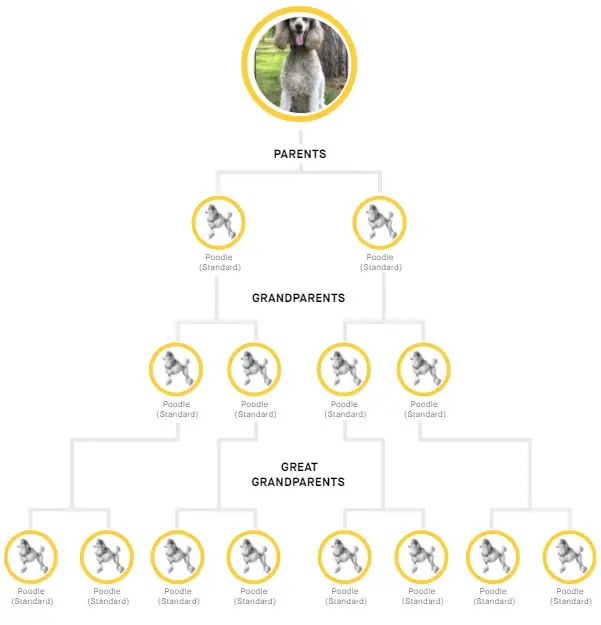
In addition to telling you your poodle`s lineage, Embark will also tell you if your poodle is prone to develop any genetic health problems in the future.
Poodle`s are genetically prone to certain health problems such as Degenerative Myelopathy, Progressive Retinal, Von Willebrand Disease. If you get your poodle from a good breeder, it is very likely that your breeder had screened your poodle`s parent for these genetic health problems before letting your poodle`s parents mate to produce offspring.
Good breeders won`t allow poodles with genetic health problems to mate and produce puppies that are likely to inherit genetic health problems form the parents. Thus, if your poodle is from a responsible breeder that does health tests, it is unlikely that your poodle has inherited any of these health problems.
However, there is no harm in doing a genetic health test on your poodle even if your breeder did it on your poodle`s parent but not on your poodle. This can help you plan for your poodle`s future. For example, if Embark tells you your poodle is predisposed to health problems, then it would be wise of you to get your poodle health insurance to avoid future medical bills.

Embark genetic tests can tell you if your poodle is a carrier of the following genetic health defects:
- Degenerative Myelopathy
- Neonatal Encephalopathy with Seizures
- Osteochondrodysplasia, Skeletal Dwarfism
- Progressive Retinal Atrophy
- Von Willebrand Disease
- Chondrodystrophy and Intervertebral Disc Disease
- GM2 Gangliosidosis
Here is an article where I discussed health problems in poodles and how to avoid them.
Furthermore, an Embark test will tell you what physcial traits your poodle has or what physcial traits your poodle will develop in the future. This is exciting information for new poodle puppy owners that want to have a glimpe into a puppy`s future.
For example, an Embark test will tell you what poodle coat color, eye color, body size, coat length, poodle coat shedding level, etc. that your poodle will have based on what they find in your poodle`s genetic makeup.

The downside of Embark test is that it goes back `only` 3 generations. Although 3 generations is a long time, however, you might want to know what dog breeds constitute the fourth generation or before of your poodle`s ancestors. Unfortunately, Embark cannot go back this far.
Poodle Genetic Test Through a Veterinarian
In addition to home genetic testing, owners opting for genetic tests to screen for certain genetic medical conditions or that are seeking the results to use in a breeding program should always opt for testing through a veterinarian. Your veterinarian can guide you on what tests are appropriate for your dog and, most importantly, counsel you on what the results of the genetic tests mean. Though many testing companies keep their testing methodology private, veterinarians know which labs have the most accurate results for specific tests. Many commercially available tests appear to test for a vast array of genetic disorders, but in reality, very few of those mutations will apply to a poodle. A veterinarian can order only the necessary tests.
How to Tell If Poodle is Purebred from Poodle Appearance
As I mentioned earlier, people sometimes confuse a poodle for a doodle especially if the poodle has long unclipped hair.
However, there as some physical traits of the poodle that can be used to identify a purebred poodle. The Poodle Club of America (PCA) has something called the poodle breed standard. This breed standard specifies what a purebred poodle should look like. We will discuss how you can identify a purebred poodle based on the poodle breed standard.
A less accurate but also less expensive method to determine if your poodle is purebred is by its appearance as per the breed standard. Purebred poodles have a distinct appearance that is easily recognizable.
Purebred Poodle Height
Purebred poodles come in three varieties: (all measurements at the shoulder)
- Toy – The toy poodle size is 10 inches and under
- Miniature – The miniature poodle size is 10 inches but not over 15 inches
- Standard – The standard poodle size is Over 15 inches (usually 22-27 inches)
If your poodle does not fall into one of these height categories, it might not be a purebred poodle.
There is another poodle size called the Moyen poodle. The Moyen poodle size lies between the standard poodle size and the miniature poodle size. The Moyen poodle is not recognized by the American Kennel Club, but it is recognized by dog clubs in Europe.
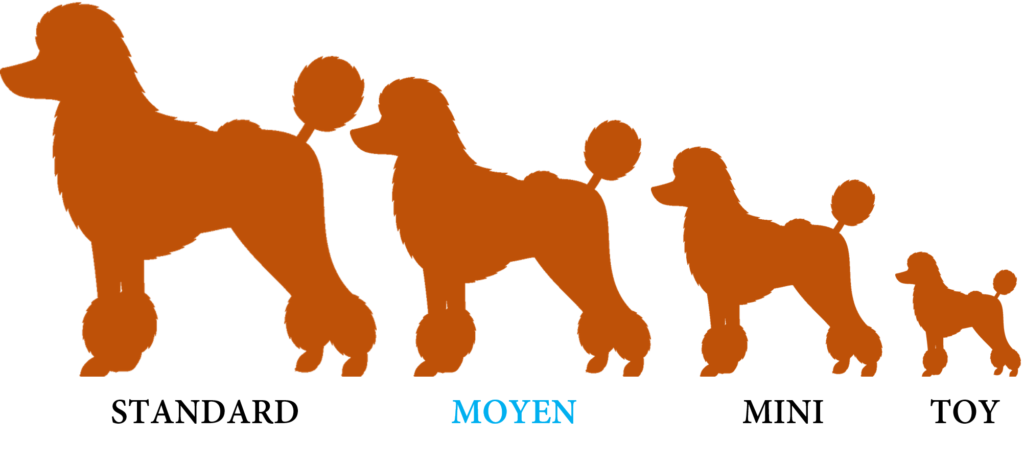
The Purebred Poodle Coat
Purebred poodles will have a curly, non-shedding coat that grows continuously, comes in many colors, as well as a parti coat pattern. Poodles come in the following colors:
- Black
- White
- Red
- Blue
- Gray
- Silver
- Brown
- Cafe-au-lait
- Apricot
- Cream, etc
Learn more about all the poodle colors in our comprehensive articles on poodle colors.
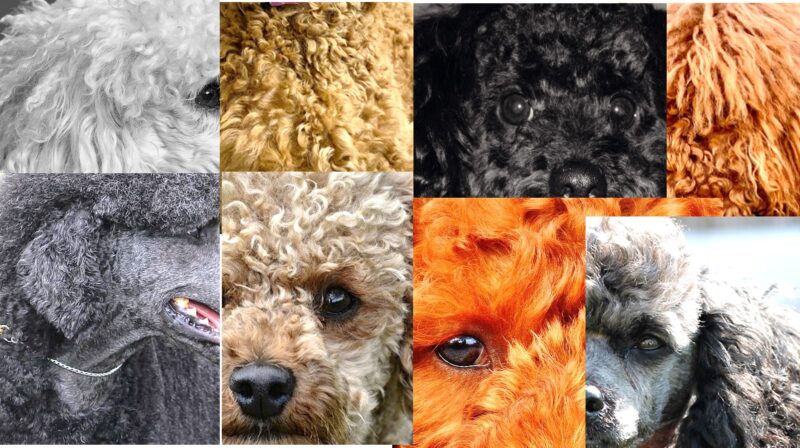
The Purebred Poodle Body Structure
According to the poodle breed standard, purebred poodles have bodies that are sturdy, with a straight topline and shoulders that are broader than their hips. Their tails are set high on their rumps and are straight. A purebred poodle’s head should appear gently round with a muzzle with a proportional length and good bone structure. The feet of a purebred poodle are a unique feature of the poodle breed as they are small and delicate compared to other breeds of similar size.
When trying to determine visually if a poodle is purebred, it may be helpful to elicit the help of your veterinarian as they have years of experience with both purebred and mixed breed dogs.

Purebred Poodle Color Markings: Nose Color, Eye color, Eye-rim Color and Lip color
Another way to tell if a poodle is purebred is by checking the color of its markings such as its Nose Color, Eye color, Eye-rim Color, and Lip color. A poodle of a particular coat color should have markings of particular colors as shown in the table below. However, note that this method is just a guide and it is not a very accurate way to tell if a poodle is purebred.
| Poodle Coat Color | Color of Markings |
| Brown and Cafe-au-lait | liver-colored noses, eye-rims, and lips, dark toenails and dark amber eyes |
| Black, Blue, Gray, Silver, Cream, and White | black noses, eye-rims and lips, black or self-colored toenails, and very dark eyes |
| Apricot | black noses, eye-rims and lips, black or self-colored toenails, and very dark eyes (preferred) liver-colored noses, eye-rims and lips, and amber eyes (permitted) |

The Temperament of a Purebred Poodle
According to the poodle breed standard, a purebred poodle should carry himself proudly, be very active, and be intelligent. A purebred poodle should have about him an air of distinction and dignity peculiar to himself. A purebred poodle should not be shy or sharp.
Learn more about poodle temperament here.
How You Can Know if a Poodle is Purebred from its Breeder
The first thing any potential puppy buyer should do when considering bringing a puppy into their family is to research the breeder. A responsible breeder is the absolute best place to find a purebred poodle puppy. Some good ways to find such a breeder are to ask your veterinarian, other poodle owners, and local breed associations for referrals.
Once narrowed down, you must meet with and get to know the breeder. Tour the facility and observe how their dogs are cared for. Ask questions about the breeding program. You will want to ask if the breeder has any certifications or licenses. Most importantly, ask to see the parents of the puppy you are considering. Observe their temperament, their physical characteristics, and health. Ask for thorough health history. A quality, purebred poodle breeder will not hesitate to show you their operation and will take impeccable care of their poodles.
Once you arrive at the facility, there are some essential things that indicate a high-quality breeder. First, all dogs will be appropriately housed and obviously well cared for. Also, the breeder will be knowledgeable about the breed and will be eager to educate prospective puppy buyers. Additionally, good breeders provide high-quality veterinary care for their dogs and typically offer a money-back guarantee on the puppies they sell. Proof of the pedigree of each pup, reaching back many generations, should be provided. Many times, a reputable breeder will help a potential owner feel confident that the puppy they are getting is purebred.
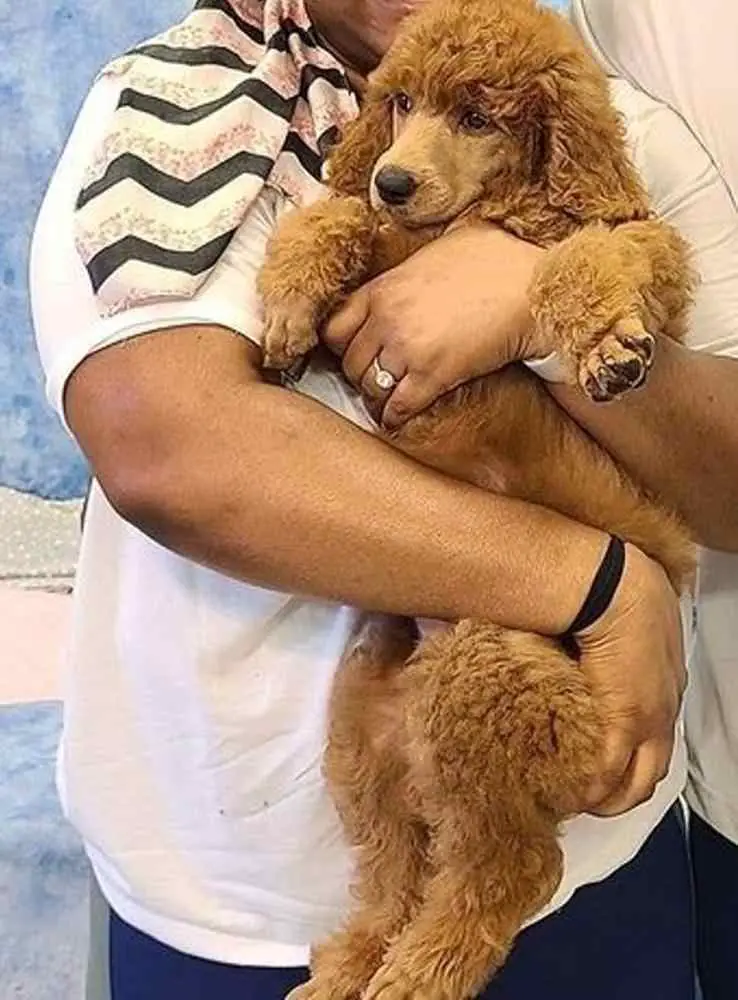
FAQs about Purebred Poodles
Are Merle Poodles purebred?
That is a tough question to answer. In an earlier article, I wrote about Merle poodles and the controversies surrounding them. A brief recap is that Merle is a color pattern of typically a gray base coat with patches of black or dark gray. There were no merle poodles until recently that we start seeing them. The merle pattern results from a gene passed to a puppy from both the mother and father. One problem with the merle poodle color pattern is that it is associated with several health issues. Although there are a lot of healthy merle poodles around.
I have heard situations where merle poodles pass the Embark test as purebred poodles. However, as I mentioned, Embark tests only go back 3 generations.
How much does a purebred poodle cost?
Costs for purebred poodles vary based on location and breeder, but typically a Standard Poodle will range from $1,500 – $2000, and a toy or miniature poodle will range from $2000 – $2500.
Here are detailed articles on how much standard poodles cost, how much miniature poodle cost, and how much toy poodles cost.
Are parti poodles purebred?
Parti poodles may or may not be purebred. The parti poodle is a color pattern, and they have strict rules to be considered parti colored, but they can be purebred poodles and can be registered with the AKC. At least 50% of their coat has to be white to qualify as parti. They can only be shown in AKC obedience and agility events. However, parti poodles cannot compete in AKC conformation events.
Can purebred poodles have blue eyes?
A purebred poodle can have blue eyes, though the breed standard is dark brown eyes. As with any dog with persistent blue eyes, a thorough examination by a veterinarian is warranted. Blue eyes in adult dogs can be a sign of a multitude of medical conditions.
Can purebred poodles be multicolored?
No, according to the AKC, poodles can be blues, gray, silver, brown, cafe-au-lait, apricot, or cream. The exception to the solid color rule would be parti poodles, but they cannot be shown in AKC conformation events.
Are purebred poodles aggressive?
Poodles, in general, are sweet and intelligent dogs that make great family pets. As a breed, poodles are not known for aggression. However, just like people, every dog is an individual, and aggression in dogs is a result of genetics, life experiences, and environment. If your poodle displays signs of aggression, a board-certified veterinary behaviorist should be consulted.

Conclusions
Modern technology has made it easy to identify a purebred poodle. Embark genetic testing is a very accurate method that you can use to tell if your poodle is purebred. In addition, embark will tell you interesting information about your poodle`s past, and its likely future.
Other methods such as looking at the physical features and temperament of your poodle can help tell you if your poodle is purebred. However, these methods are not as scientific and accurate as genetic tests.

